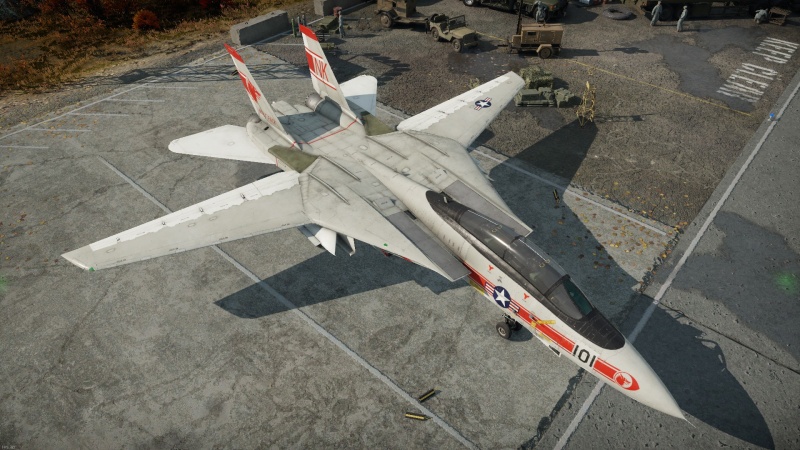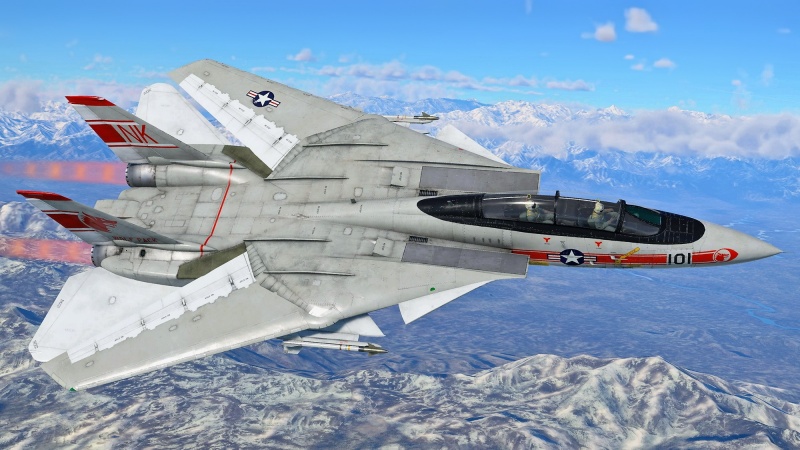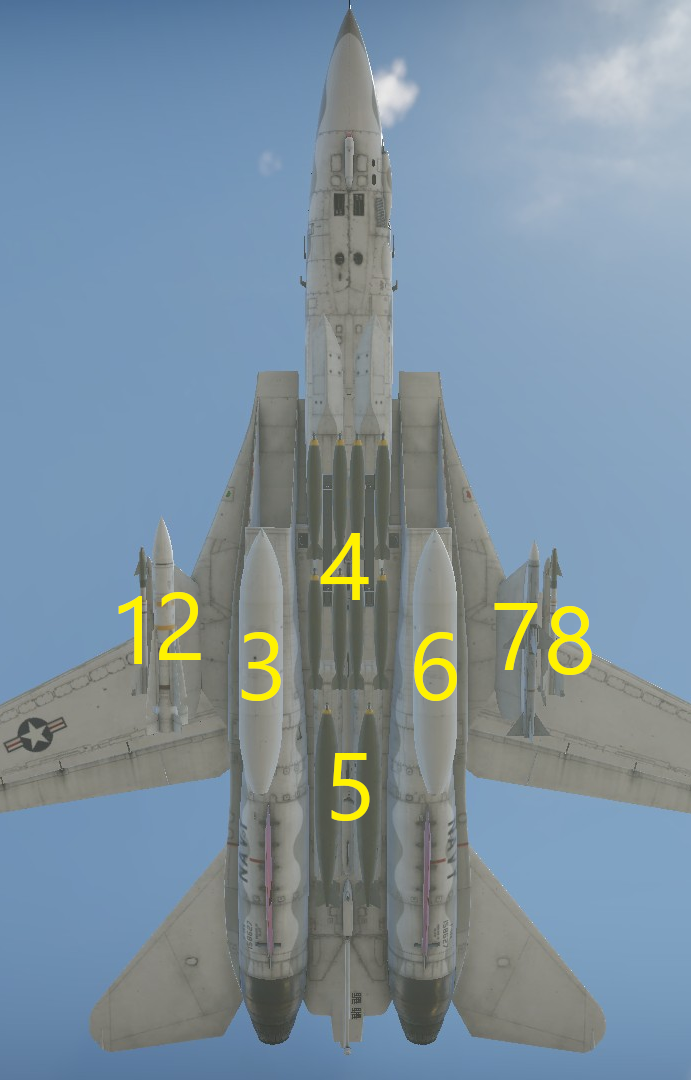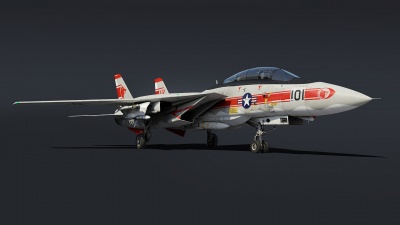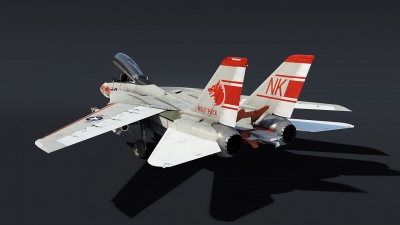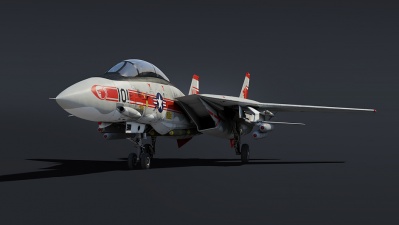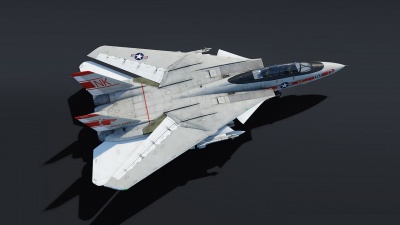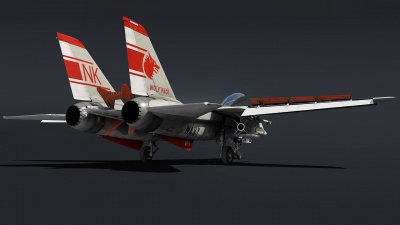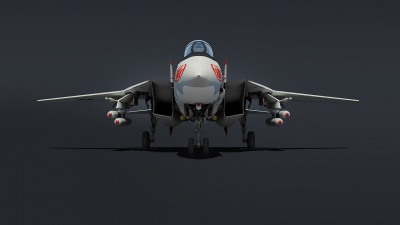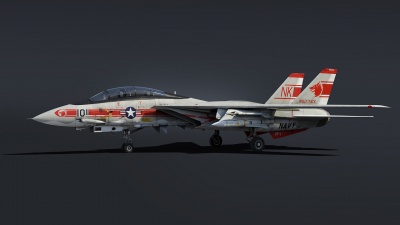Difference between revisions of "F-14A Early"
m |
m (→Usage in battles) |
||
| Line 215: | Line 215: | ||
The F-14A Tomcat is an energy and air-superiority fighter and should be used as such. A mix between long-range weapons and short-range weapons must be used at pilot's discretion. It is advised to never turn fight with the Tomcat unless absolutely necessary as the speed will bleed drastically, leaving it as an easy target for enemy aircraft and anti-air. The range of the missiles can be drastically increased if the Tomcat is positioned above its target. The missiles will not only increase speed but distance as well, this should be taken into consideration as it can take unaware targets as they never expect to be hit from the top. Thankfully, both the Sparrow and the AIM-54A are able to do all-aspect attacks on enemies, making it an all-rounder weapon for all sorts of medium-long range scenarios. The F-14A is especially practical when playing Enduring Confrontation battles as it is able to engage multiple targets at a time with the AIM-54A at extreme ranges, useful for taking down enemy attackers, scouts and players. It should be noted that the F-14A burns up fuel very fast when on afterburner. This should be taken into consideration as one can burn up all the fuel without realizing until it is too late. | The F-14A Tomcat is an energy and air-superiority fighter and should be used as such. A mix between long-range weapons and short-range weapons must be used at pilot's discretion. It is advised to never turn fight with the Tomcat unless absolutely necessary as the speed will bleed drastically, leaving it as an easy target for enemy aircraft and anti-air. The range of the missiles can be drastically increased if the Tomcat is positioned above its target. The missiles will not only increase speed but distance as well, this should be taken into consideration as it can take unaware targets as they never expect to be hit from the top. Thankfully, both the Sparrow and the AIM-54A are able to do all-aspect attacks on enemies, making it an all-rounder weapon for all sorts of medium-long range scenarios. The F-14A is especially practical when playing Enduring Confrontation battles as it is able to engage multiple targets at a time with the AIM-54A at extreme ranges, useful for taking down enemy attackers, scouts and players. It should be noted that the F-14A burns up fuel very fast when on afterburner. This should be taken into consideration as one can burn up all the fuel without realizing until it is too late. | ||
| − | Something to be aware of when playing the F-14A is the insane heat of its engines. At high throttle and afterburner, its engines emit an unparalleled amount of heat at around 2, | + | Something to be aware of when playing the F-14A is the insane heat of its engines. At high throttle and afterburner, its engines emit an unparalleled amount of heat at around 2,100 °F (1,150 °C). For reference, that is around 66% hotter than the F-4J's engines, which is around 1,239 °F (671 °C) at 100% throttle and 1,256 °F (680 °C) during full afterburner. During gameplay, this means that in the F-14A, just turning off the afterburner and deploying flares may not be enough to avoid an incoming IR missile. You will also have to throttle down the engine significantly (at least 85%) to make sure that an incoming IR missile goes for the flare. This also means that you will lose a decent amount of speed in the process, so be prepared. |
=== Pros and cons === | === Pros and cons === | ||
Revision as of 14:38, 4 July 2022
Contents
Description
The F-14A Tomcat (Early) is a rank American jet fighter with a battle rating of (AB), (RB), and (SB). It was introduced in Update "Danger Zone".
General info
Flight performance
The F-14A might be seen underpowered compared to other aircraft, primarily the F-4J Phantom II and other Phantom variants such as the Phantom FG.1. While it is true that the engines are not as powerful, the flight performance of the F-14A is much better when it comes to top speed and energy attacks, but insufficient power can be noticed when zoom climbing, or when turning at low speed. Regaining the speed back can take a while. The other problem related to the engine is the tremendous fuel consumption: while with the full fuel tanks it can stay in the air for at least one hour, but when the player decides to use the full afterburner (WEP) it can fly for only 7 minutes at sea level.
The F-14A is more of a two circle dogfighter since it keeps speed very well while pulling lots of G, but might not have as much AoA (Angle of Attack) available as other planes to win one circle fights (scissors and anything similar when you turn into the opponent's nose); though it can still beat planes like the MiG-23MLD in the instantaneous turn rate performance, delta wing fighters like the J35 or MiG-21 could have the advantage during the first seconds of the fight. Just like in other planes with variable wing geometry, the F-14A reaches the highest turn rate performance when wings are swept fully forward (so set to 0%) and that can be achieved only by using the manual wing sweep controls. Since it is semi-automatic, the wing will automatically change its position after reaching around ~800 km/h IAS.
The most optimal speed for turning is around 900 km/h IAS at sea level (it reaches the highest sustained turn rate there), but the best is actually between 700 and 830 km/h IAS since any faster and it becomes impossible to maintain the turn without the crew blacking out. At those speeds, the F-14A in a clean configuration with 30 minutes of fuel can reach up to 23 deg/s of sustained turn rate, which is better than any MiG-23, Su-17, or even other more manoeuvrable fighters like the MiG-19. Both the sustained and instantaneous turn rate can be improved by using combat flaps, they can increase the turn rate at the speeds up to 850 km/h IAS.
Thanks to the variable wing sweep, the F-14A is able to move its center of mass and thus increase or decrease its roll rate. High sweep means higher speeds at reduced roll rate and vice versa; low sweep means slower speeds at an increased roll rate, but also increased energy retention at subsonic speeds.
To get the most of its turn rate performance in Simulator Battles you should always try to use the manual SAS (Stability Augmentation System) mode, the damping mode limits its AoA too much and it is harder to win fights against planes like the MiG-21 or other deltas. The combat flaps should also always be used when you are about to merge with the enemy plane, they do not only increase the sustained turn rate, but also make it so you can pull AoA, it is easier to get lead on the enemy plane, they also make it easier to control the plane when the manual SAS mode is being used. The player should still be very careful with pulling the stick around 500 km/h IAS, below that speed it's very easy to reach the critical AoA and stall out the plane and if not then lose lots of speed, pulling the stick all the way to yourself should be done only when you are going for snap shots. The other downside of using the manual SAS mode except for the plane being much easier to stall out is also making it much more sensitive to controls, especially in pitch, during the cruising and BVR engagements it is recommended to use the damping SAS mode.
| Characteristics | Max Speed (km/h at 12,192 m) |
Max altitude (metres) |
Turn time (seconds) |
Rate of climb (metres/second) |
Take-off run (metres) | |||
|---|---|---|---|---|---|---|---|---|
| AB | RB | AB | RB | AB | RB | |||
| Stock | 2,202 | 2,191 | 24.4 | 25.1 | 178.4 | 170.5 | 750 | |
| Upgraded | 2,245 | 2,221 | 23.6 | 24.0 | 231.6 | 203.8 | ||
Details
| Features | |||||
|---|---|---|---|---|---|
| Combat flaps | Take-off flaps | Landing flaps | Air brakes | Arrestor gear | Drogue chute |
| ✓ | ✓ | ✓ | ✓ | ✓ | X |
| Limits | Wings (km/h) | Gear (km/h) | Flaps (km/h) | Max Static G | |||
|---|---|---|---|---|---|---|---|
| Combat | Take-off | Landing | + | - | |||
| Min sweep | 1,359 | 1,200 | 873 | 416 | ~10 | ~4 | |
| Max sweep | 1,555 | ~12 | ~4 | ||||
| Optimal velocities (km/h) | |||
|---|---|---|---|
| Ailerons | Rudder | Elevators | Radiator |
| < ___ | < ___ | < ___ | N/A |
Engine performance
| Engine | Aircraft mass | ||||||||
|---|---|---|---|---|---|---|---|---|---|
| Engine name | Number | Basic mass | Wing loading (full fuel) | ||||||
| Pratt & Whitney TF30-P-412A | 2 | 18,545 kg | 493 kg/m2 | ||||||
| Engine characteristics | Mass with fuel (no weapons load) | Max Gross Weight | |||||||
| Weight (each) | Type | 18m fuel | 20m fuel | 30m fuel | 45m fuel | 62m fuel | |||
| 1,802 kg | Afterburning low-bypass turbofan | 20,750 kg | 20,905 kg | 22,085 kg | 23,855 kg | 25,895 kg | 30,935 kg | ||
| Maximum engine thrust @ 0 m (RB/SB) | Thrust to weight ratio @ 0 m (WEP) | ||||||||
| Condition | 100% | WEP | 18m fuel | 20m fuel | 30m fuel | 45m fuel | 62m fuel | MGW | |
| Stationary | 4,860 kgf | 8,019 kgf | 0.77 | 0.77 | 0.73 | 0.67 | 0.62 | 0.52 | |
| Optimal | 5,808 kgf (1,555 km/h) |
12,692 kgf (1,555 km/h) |
1.22 | 1.21 | 1.15 | 1.06 | 0.98 | 0.82 | |
Survivability and armour
The F-14A holds 60 countermeasures, a decent amount of flares that can keep the Tomcat in the air for longer. Due to the massive engines, the IR signature of the aircraft is not an easy thing to conceal when fighting heat-seeking missiles. Afterburners should be turned off and preferably throttle should be reduced while dumping flares. This is to ensure that IR guided missiles track the flares and not the engines. Due to the massive size compared to other aircraft, the chances of a successful hit from enemies, both missile and cannon, are higher compared to other aircraft, such as the AV-8 or F-5. This should be taken into consideration as proximity fuzes will trigger with more ease as the wingspan of the Tomcat is considerably larger than most jets seen in game.
Modifications and economy
Armaments
| Ballistic Computer | |||
|---|---|---|---|
| CCIP (Guns) | CCIP (Rockets) | CCIP (Bombs) | CCRP (Bombs) |
| |
|
|
|
Offensive armament
The F-14A Early is armed with:
- A choice between two presets:
- 1 x 20 mm M61A1 cannon, cheek-mounted (676 rpg)
- 1 x 20 mm M61A1 cannon + 60 x countermeasures
Suspended armament
The F-14A Early can be outfitted with the following ordnance presets:
- Without load
- 2 x AIM-9D Sidewinder missiles
- 4 x AIM-9D Sidewinder missiles
- 4 x AIM-9G Sidewinder missiles
- 4 x AIM-9H Sidewinder missiles
- 6 x AIM-7E Sparrow missiles
- 6 x AIM-7F Sparrow missiles
- 6 x AIM-54A Phoenix missiles
- 14 x 250 lb LDGP Mk 81 bombs (3,500 lb total)
- 14 x 500 lb LDGP Mk 82 bombs (7,000 lb total)
- 4 x 1,000 lb LDGP Mk 83 bombs (4,000 lb total)
- 4 x 2,000 lb LDGP Mk 84 bombs (8,000 lb total)
- 16 x Zuni Mk32 Mod 0 ATAP rockets
The F-14A is the first aircraft in game to have access to Active Radar Homing missiles with internal navigation. While it is mostly used for air defense and anti-air duties, it holds decent ground pounding abilities that are nothing new to American pilots. The F-14A has access to a wide variety of weapon selections due to having 'Custom Loadouts' feature. Depending on the needs of the pilot, one can carry different loadouts for different needs. Some may prefer the use of the AIM-7F over the AIM-54 due to the fast acceleration and good performance in short-medium ranges. A recommended loadout to carry is the following: x4 AIM-54A, x2 AIM-7F, x2 AIM-9 (on preference). It holds the power to fight on all ranges, being able to launch AIM-54A at unaware targets and then engage other with Sparrows, later to dogfight at close ranges with Sidewinders.
Custom loadout options
| 1 | 2 | 3 | 4 | 5 | 6 | |||
|---|---|---|---|---|---|---|---|---|
| 250 lb LDGP Mk 81 bombs | 8* | 6 | ||||||
| 500 lb LDGP Mk 82 bombs | 8* | 6 | ||||||
| 1,000 lb LDGP Mk 83 bombs | 2* | 2 | ||||||
| 2,000 lb LDGP Mk 84 bombs | 2*† | 2 | ||||||
| Zuni Mk32 Mod 0 ATAP rockets | 8 | 8 | ||||||
| AIM-7E Sparrow missiles | 1 | 2 | 1, 2* | 1 | ||||
| AIM-7F Sparrow missiles | 1 | 2 | 1, 2* | 1 | ||||
| AIM-9D Sidewinder missiles | 1 | 1 | 1 | 1 | ||||
| AIM-9G Sidewinder missiles | 1 | 1 | 1 | 1 | ||||
| AIM-9H Sidewinder missiles | 1 | 1 | 1 | 1 | ||||
| AIM-54A Phoenix missiles | 1 | 2* | 2† | 1 | ||||
| * Use of dual Sparrow missiles on hardpoint 4 prevents use of the marked options on hardpoint 3 † The AIM-54A Phoenix missiles on hardpoint 4 cannot be carried in conjunction with 2,000 lb LDGP Mk 84 bombs on hardpoint 3 | ||||||||
Usage in battles
The F-14A Tomcat is an energy and air-superiority fighter and should be used as such. A mix between long-range weapons and short-range weapons must be used at pilot's discretion. It is advised to never turn fight with the Tomcat unless absolutely necessary as the speed will bleed drastically, leaving it as an easy target for enemy aircraft and anti-air. The range of the missiles can be drastically increased if the Tomcat is positioned above its target. The missiles will not only increase speed but distance as well, this should be taken into consideration as it can take unaware targets as they never expect to be hit from the top. Thankfully, both the Sparrow and the AIM-54A are able to do all-aspect attacks on enemies, making it an all-rounder weapon for all sorts of medium-long range scenarios. The F-14A is especially practical when playing Enduring Confrontation battles as it is able to engage multiple targets at a time with the AIM-54A at extreme ranges, useful for taking down enemy attackers, scouts and players. It should be noted that the F-14A burns up fuel very fast when on afterburner. This should be taken into consideration as one can burn up all the fuel without realizing until it is too late.
Something to be aware of when playing the F-14A is the insane heat of its engines. At high throttle and afterburner, its engines emit an unparalleled amount of heat at around 2,100 °F (1,150 °C). For reference, that is around 66% hotter than the F-4J's engines, which is around 1,239 °F (671 °C) at 100% throttle and 1,256 °F (680 °C) during full afterburner. During gameplay, this means that in the F-14A, just turning off the afterburner and deploying flares may not be enough to avoid an incoming IR missile. You will also have to throttle down the engine significantly (at least 85%) to make sure that an incoming IR missile goes for the flare. This also means that you will lose a decent amount of speed in the process, so be prepared.
Pros and cons
Pros:
- Excellent turn rate despite being a large and heavy plane
- 60 countermeasures provides good ability to ward off missiles
- Lethal M61 Vulcan cannon which has an extremely fast fire rate, great velocity, and great damage
- Can carry up to 8 missiles maximum, with options of AIM-7s, AIM-9s, and AIM-54s for versatile use
- The AIM-54 has insane range (100 km max), its rocket booster lasts for a very long time, and it's an Active Radar Homing missile
- Very effective dogfighter at any speeds with its variable wing sweep thus being one of the best energy retaining jet fighters
- Variable swept wings can help plane accelerate fast when it's swept back and turn better when the wing is less swept
- High top speed (can cap out at 1500 km/h IAS at sea level)
- Multi-mode radar makes it effective at any situation (The TWS mode allows launching AIM-54s at multiple aircraft at once)
- The new AIM-9H has much better flare resistance than previous AIM-9s (such as the G or J variants)
Cons:
- Big plane and thus an easy target to hit
- The afterburner's fuel consumption is otherworldly fast; constant usage of it requires carrying a lot of fuel that can hamper the plane's performance and manoeuvrability
- Massive wing and fuselage fuel tanks makes it especially prone to catching fire
- Cannot pull sustained Gs when above 1000 km/h IAS (11-13 Gs) or the wings will rip
- At high throttle and afterburner, the engine emits an unparalleled amount of heat, requiring throttling down (and therefore significantly bleeding speed) to reliably flare missiles off
- The AIM-54A only has 16G overload and thus is rather easy to dodge
- The AIM-54A's rocket motor lasts for a very long time, giving plenty of time for enemies to spot and evade it
History
Early Development
In 1967, the U.S. Navy wanted a long-range fleet defence fighter to boost their naval plane capabilities with the "VFX" program. The USN first started with a redesigned F-111 Aardvark named the F-111B (basically an F-111 designed around the TF30 engine and AIM-54 Phoenix missiles), they soon found out that the F-111 was too big for practical reasons so the F-111B plan never came to fruition. Fast forward to 1969, the USN gave the contract to Grumman to build the new fleet defence fighter named the F-14 Tomcat, its first variants were built around the TF30 engines found on the F-111B and to use the AN/AWG-9 radar set and the airframe was specifically built to carry the AIM-54 Phoenix missile.
Devblog
In 1968, five aircraft building companies entered the Pentagon's competition for a new carrier-based interceptor fighter. The commission's preference was given to Grumman's design, a twin-engine jet fighter with a variable-swept wing. Work on the F-14A fighter began in February 1969, and in December of the next year, the new aircraft took her maiden flight. The main weapon of the F-14A was the AIM-54 Phoenix long-range missiles controlled by the newest to date weapon control system. Instead of building prototypes, Grumman immediately switched to the production of an experimental series, and already on December 31, 1972, the first batch of jet fighters were put into service with the VF-124 Fleet Replacement Squadron . Pilot training took place on the deck of the USS Enterprise aircraft carrier, and during the withdrawal of US troops from Vietnam, combat sorties were also made from the deck. In total 557 F-14A fighters were delivered to the US Navy until 1987, and another 80 aircraft were built for Iran. Tomcats were used in all military conflicts where US aircraft took part until the very decommissioning. Iranian F-14s took an active part in the Iran-Iraq war, scoring dozens of air kills.
Media
- Images
- Videos
See also
Links to the articles on the War Thunder Wiki that you think will be useful for the reader, for example:
- reference to the series of the aircraft;
- links to approximate analogues of other nations and research trees.
External links
- [Devblog] F-14A Tomcat: Into the Danger Zone!
- Official data sheet - more details about the performance
| Grumman Aircraft Engineering Corporation | |
|---|---|
| Aircraft | |
| Fighters | |
| F3F | F3F-2 · Galer's F3F-2 |
| F4F Wildcat | F4F-3 · F4F-4 |
| XF5F Skyrocket | XF5F · XP-50 |
| F6F Hellcat | F6F-5 · F6F-5N |
| F7F Tigercat | F7F-1 · F7F-3 |
| F8F Bearcat | F8F-1 · F8F-1B |
| Jet Fighters | |
| F9F Panther/Cougar | F9F-2 · F9F-5 · F9F-8 |
| F-11 Tiger | F11F-1 |
| F-14 Tomcat | F-14A Early · F-14B |
| Jet Strike Aircraft | |
| A-6 Intruder | A-6E TRAM |
| Bombers | TBF-1C |
| Export | ▄Martlet Mk IV · ▄F6F-5 · ▄F6F-5N · ▄F8F-1B · ▄Avenger Mk II · ▄Hellcat Mk II |
| ▄F-14A IRIAF | |
| Naval Vehicles | |
| Patrol Gunboat Hydrofoil (PGH) | USS Flagstaff |
| USA jet aircraft | |
|---|---|
| Fighters | |
| F9F | F9F-2 · F9F-5 · F9F-8 |
| F-80 | F-80A-5 · F-80C-10 |
| F-84 | F-84B-26 · F-84F · F-84G-21-RE |
| F-86 | F-86A-5 · F-86F-25 · F-86F-2 · F-86F-35 |
| F-89 | F-89B · F-89D |
| F-100 | F-100D |
| F-104 | F-104A · F-104C |
| F-4 | F-4C Phantom II · F-4E Phantom II · F-4J Phantom II · F-4S Phantom II |
| F-5 | F-5A · F-5C · F-5E · F-20A |
| F-8 | F8U-2 · F-8E |
| F-14 | F-14A Early · ▄F-14A IRIAF · F-14B |
| F-15 | F-15A · F-15C MSIP II · F-15E |
| F-16 | F-16A · F-16A ADF · F-16C |
| Other | P-59A · F2H-2 · F3D-1 · F3H-2 · F4D-1 · F11F-1 |
| Strike Aircraft | |
| FJ-4 | FJ-4B · FJ-4B VMF-232 |
| A-4 | A-4B · A-4E Early |
| A-7 | A-7D · A-7E · A-7K |
| AV-8 | AV-8A · AV-8C · AV-8B Plus · AV-8B (NA) |
| A-10 | A-10A · A-10A Late · A-10C |
| F-111 | F-111A · F-111F |
| Other | A-6E TRAM · F-105D · F-117 |
| Bombers | |
| B-57 | B-57A · B-57B |



